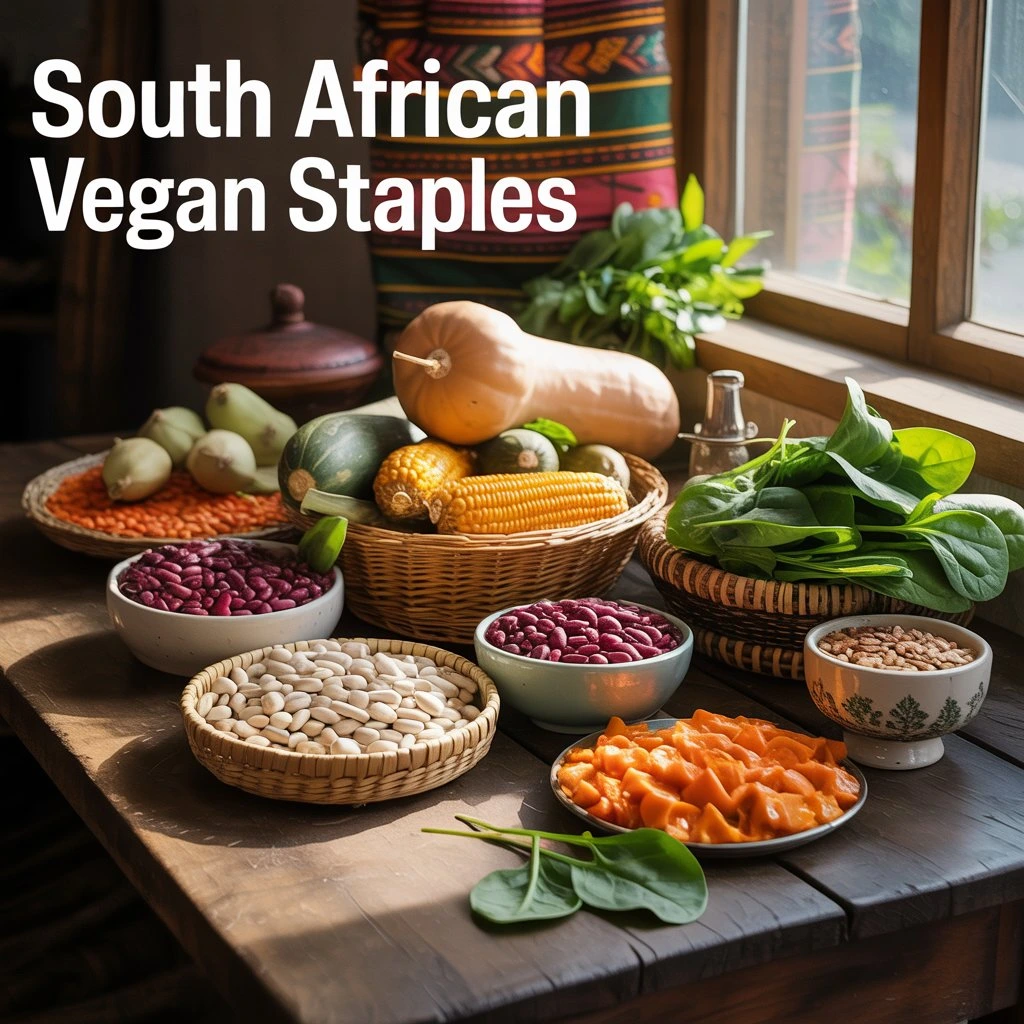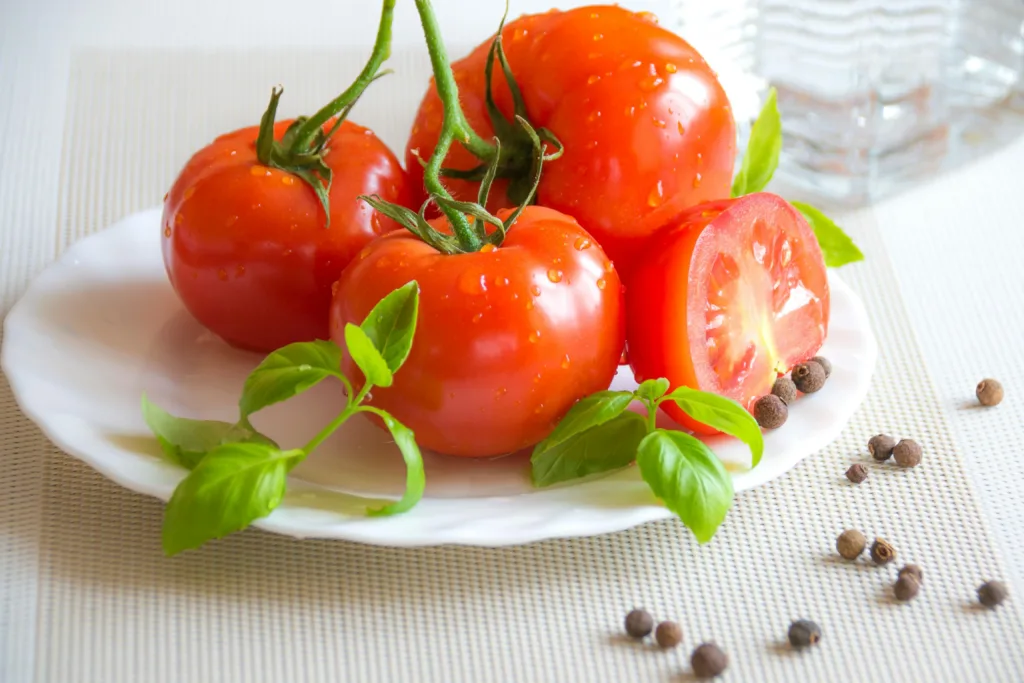Top 10 South African Vegan Staples Already in Your Kitchen

Your pantry probably holds more plant-based power than you think.
Reading time: ~10 minutes
In this article
- Mielie Meal (Maize Meal)
- Dried or Canned Beans
- Brown Rice
- Potatoes
- Onions & Garlic
- Spinach (or Morogo)
- Tomatoes
- Peanuts & Peanut Butter
- Root Vegetables
- Bananas
Why your kitchen is already plant-based
If you’ve ever thought, “Going vegan must be expensive or complicated,” here’s good news — it doesn’t have to be.
In fact, many South African kitchens are already stocked with affordable, whole-food ingredients that happen to be vegan.
From mielie meal and beans to tomatoes and morogo, anyone can turn these humble staples into nourishing meals without breaking the bank.
Below, we’ll tour 10 everyday staples and show how to turn them into balanced, flavourful meals.
Along the way, you’ll find quick tips, easy pairings, and credible resources for deeper reading.
1) Mielie Meal (Maize Meal)
Mielie meal is a South African classic. Whether you prefer creamy morning porridge or a stiff pap for dinner, this naturally vegan staple is versatile and satisfying.
Why it’s great
- Gluten-free and easily digestible
- Reliable energy from complex carbohydrates
- Adaptable to savoury and sweet dishes
Try this: Serve stiff pap with a tomato-and-bean relish or sautéed morogo for a nourishing, budget-friendly plate.
2) Dried or Canned Beans
Beans — think sugar beans, black beans, and butter beans — are the ultimate budget-friendly protein. They support satiety, gut health, and steady energy.
Why it’s great
- Rich in plant protein, iron, and fibre
- Work in stews, salads, spreads, and curries
- Affordable and widely available
Pro tip: Soak dried beans overnight to reduce cooking time and enhance digestibility.
How to cook beans from scratch
3) Brown Rice
Whole-grain rice adds fibre and minerals and pairs beautifully with lentils, chickpeas, stir-fries, and curries.
Why it’s great
- Complex carbs support longer-lasting energy
- Simple base for bowls and meal prep
- Naturally gluten-free
Quick idea: Toss cooked brown rice with mixed veg, soy sauce, and sesame seeds for a fast, flavour-packed fried rice.
4) Potatoes
Humble yet mighty, potatoes can be roasted, mashed, curried, or turned into crispy wedges for an endlessly comforting meal.
Why it’s great
- Naturally fat-free and filling
- Good source of potassium, vitamin C, and fibre (keep the skins!)
- Adapts to almost any flavour profile
Try this: Oven-bake wedges with paprika and garlic; serve with a homemade chilli-tomato dip.
5) Onions & Garlic
These aromatic all-stars build flavour in nearly every stew, curry, and sauce — while adding antioxidants and depth.
Why it’s great
- Natural flavour boosters (less reliance on salt)
- Contain helpful plant compounds and antioxidants
- Affordable with a long shelf life
Kitchen note: Sauté in a bit of oil (or water for an oil-free option) before adding vegetables and legumes to unlock maximum flavour.
6) Spinach (or Morogo)
Whether you’re using supermarket spinach or foraged morogo, leafy greens are nutrient-dense and deeply rooted in local food culture.

Why it’s great
- High in iron, folate, magnesium, and vitamin K
- Great sautéed, steamed, or blended into smoothies
- Pairs beautifully with pap and beans
Indigenous African leafy vegetables (FAO)
7) Tomatoes
From chakalaka and relishes to soups and curries, tomatoes add colour, acidity, and antioxidants to everyday meals.

Why it’s great
- Rich in lycopene, associated with heart health
- Work fresh, canned, or pureed
- Bring balance and brightness to beans and grains
Try this: Make a simple tomato-and-onion relish with a pinch of chilli and a squeeze of lemon — perfect over pap or lentil patties.
8) Peanuts & Peanut Butter
Beloved across Africa, peanuts add richness and protein to stews, sauces, and quick snacks — and they’re wonderfully budget-friendly.
Why it’s great
- Good source of healthy fats and plant protein
- Enhances sauces, baked goods, and smoothies
- Shelf-stable and versatile
Local inspiration: Peanut-and-spinach stew served with rice or pap is pure comfort food.
Nutritional benefits of peanuts
9) Root Vegetables (Carrots, Sweet Potatoes, Beetroot)
Colourful, affordable, and available year-round, root veg bring natural sweetness and a rainbow of nutrients to your plate.
Why it’s great
- High in fibre and antioxidants
- Roast well and make creamy soups
- Store easily for quick weeknight meals
Meal idea: Roast carrots, sweet potatoes, and beetroot with thyme; serve with garlicky greens and a pot of beans.
10) Bananas
The perfect snack — and a secret weapon in vegan baking. Overripe bananas add natural sweetness and help bind doughs and batters.
Why it’s great
- Potassium-rich quick energy
- Great binder for cookies, flapjacks, and breads
- Reduces food waste when used ripe
Try this: Mash ripe bananas with oats and peanut butter for three-ingredient cookies — ideal for school lunches or post-workout snacks.
Bonus picks: Lentils, Cabbage & Seasonal Veg
While not in the top ten, lentils, cabbage, and seasonal produce like butternut and green beans are all-stars for soups, curries, and stews. Build meals around what’s in season to save money and maximise flavour.
Seasonal produce guide (South Africa)
How to build a balanced plant-based plate
Here’s a simple, repeatable formula to make dinner a breeze:
- Base: Mielie meal, brown rice, or potatoes
- Protein: Beans, lentils, or peanuts
- Veg: Spinach/morogo, tomatoes, carrots, beetroot
- Flavour: Onion, garlic, herbs, spices, citrus
Mix and match, and you’ll have endless combinations — from pap with chakalaka beans to rice bowls topped with garlicky greens and roasted veg.
Why these staples matter
- Save money: Cook once, eat twice; buy dry goods in bulk when possible.
- Eat for health: Fibre-rich whole foods support gut, heart, and metabolic health.
- Live sustainably: Local, seasonal produce reduces waste and supports communities.
You don’t need imported superfoods to thrive; your pantry already holds the goods — you call them pap, beans, and spinach.
Ready to cook with what you have?
Start with a straightforward swap this week and build from there. For more local, budget-friendly recipes and meal plans, explore Eating Plant-Based ZA.
References & helpful resources
- Health benefits of cornmeal
- How to cook beans from scratch
- Benefits of whole grains
- Potato nutrition facts
- Garlic and onion benefits
- Indigenous African leafy vegetables (FAO)
- Tomatoes and health benefits
- Nutritional benefits of peanuts
- Why eat more root vegetables
- Banana health benefits
- Seasonal produce guide (South Africa)
© Eating Plant-Based ZA • All rights reserved.
